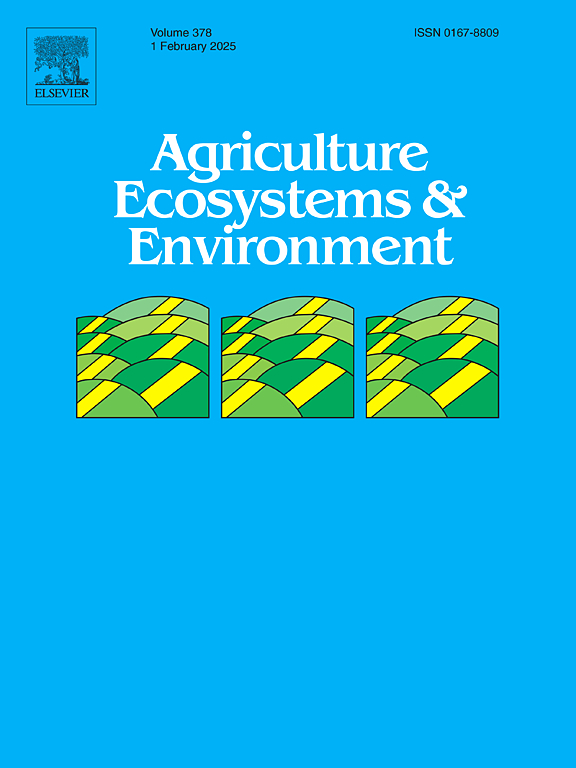GHG balance, its seasonality and response to soil type and management of northern agricultural grasslands: Eddy-covariance flux measurements from three adjacent fields in Finland
IF 6
1区 农林科学
Q1 AGRICULTURE, MULTIDISCIPLINARY
引用次数: 0
Abstract
Understanding how managed grasslands respond to climate and management regimes across global pedoclimatic zones is crucial to combating climate change. In this study, we used the eddy covariance method to continuously measure GHG fluxes from January through December 2022 at three boreal grassland sites in eastern Finland: Anttila on mineral soil, and Särkisuo and Pappilansuo on drained peat soils. Our results highlight significant seasonal variability and a strong dependence on management events (such as summer plowing at Pappilansuo, fertilization, and harvest at all three sites). The net CO2 exchange ranged from a strong net uptake at Anttila (–2500 kg C ha−1 yr−1) and moderate uptake at Särkisuo (–500 kg C ha−1 yr−1) to net release at Pappilansuo (+930 kg C ha−1 yr−1). CH4 fluxes were negligible at Anttila (total of +2 kg CH4 ha−1 yr−1) but reached + 110 kg CH4 ha−1 yr−1 at Särkisuo and + 51 kg CH4 ha−1 yr−1 at Pappilansuo. N2O emissions peaked after fertilization with + 3.8 (Anttila), + 16 (Särkisuo), and + 29 kg N₂O ha−1 yr−1 (Pappilansuo). Anttila remained a net GHG sink at approximately –8.0 t CO2-eq ha−1, whereas Särkisuo and Pappilansuo were net sources of 5.0 and 12.3 t CO2-eq ha−1, respectively. Anttila had the lowest GHG emissions per kilogram of grass biomass produced and had the highest yield, illustrating the potential for more climate-friendly grassland management on suitable soils. However, the organic soils showed higher GHG emissions. These results highlight the influence of soil type and the importance of management timing on the overall GHG balance in boreal grasslands.
北方农业草地温室气体平衡、季节性及其对土壤类型和管理的响应:芬兰三个相邻田的涡旋协方差通量测量
了解受管理的草原如何对全球气候带的气候和管理制度做出反应,对于应对气候变化至关重要。在这项研究中,我们使用涡旋相关方差方法连续测量了2022年1月至12月芬兰东部三个北方草原的温室气体通量:安提拉在矿物土壤上,Särkisuo和Pappilansuo在排干泥炭土上。我们的研究结果强调了显著的季节变化和对管理事件的强烈依赖(如Pappilansuo的夏耕、施肥和所有三个地点的收获)。净CO2交换范围从安提拉岛的强净吸收(-2500 kg C ha−1年−1)和Särkisuo的中等吸收(-500 kg C ha−1年−1)到Pappilansuo的净释放(+930 kg C ha−1年−1)。CH4通量在安提拉岛可以忽略不计(总计+2 kg CH4 ha−1年−1),但在Särkisuo和Pappilansuo分别达到+ 110 和+ 51 kg CH4 ha−1年−1。N2O排放在施肥后达到峰值,为+ 3.8(安提拉)、+ 16 (Särkisuo)和+ 29 kg N₂O ha - 1 year - 1 (Pappilansuo)。安提拉岛仍然是温室气体净汇,约为-8.0 t CO2-eq ha - 1,而Särkisuo和Pappilansuo分别是5.0和12.3 t CO2-eq ha - 1的净源。安提拉每千克草生物量的温室气体排放量最低,产量最高,表明在适宜土壤上进行气候友好型草地管理的潜力。有机土壤的温室气体排放量较高。这些结果突出了土壤类型和管理时机对北方草原总体温室气体平衡的影响。
本文章由计算机程序翻译,如有差异,请以英文原文为准。
求助全文
约1分钟内获得全文
求助全文
来源期刊

Agriculture, Ecosystems & Environment
环境科学-环境科学
CiteScore
11.70
自引率
9.10%
发文量
392
审稿时长
26 days
期刊介绍:
Agriculture, Ecosystems and Environment publishes scientific articles dealing with the interface between agroecosystems and the natural environment, specifically how agriculture influences the environment and how changes in that environment impact agroecosystems. Preference is given to papers from experimental and observational research at the field, system or landscape level, from studies that enhance our understanding of processes using data-based biophysical modelling, and papers that bridge scientific disciplines and integrate knowledge. All papers should be placed in an international or wide comparative context.
 求助内容:
求助内容: 应助结果提醒方式:
应助结果提醒方式:


